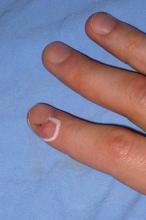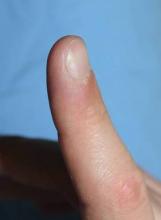User login
Laser-induced thermotherapy combined with a fractional laser successfully eradicated the majority of persistent warts in a study of 20 patients.
Subclinical infection with human papillomavirus verruca vulgaris infection (due to HPV types 1, 2, and 4) and condyloma acuminata (due to HPV types 6 and 11) often persists after eradication.
Photodynamic therapy (PDT) with topical application of 5-aminolevulinic acid (5-ALA) has previously been shown to be an effective treatment for such warts located in difficult anatomic areas, said Dr. Leonardo Marini, who is in private practice in Trieste, Italy.
However, 5-ALA cannot penetrate deeply into the skin. Therefore, it only has U.S. Food and Drug Administration approval for superficial skin neoplasms, such as multifocal basal cell carcinomas, actinic keratoses, and Bowen's disease.
New strategies for increasing penetration through the stratum corneum include needling and ablative fractional lasers.
Animal data have confirmed the validity of CO2 lasers, showing that transcutaneous microchannels stay open up to 7 hours after a fractional laser procedure. "This opens new horizons for all kinds of topical treatments," Dr. Marini said in an interview.
Thermotherapy performed with an Nd:YAG laser has a damaging effect on viral entities and increases cutaneous reactive circulation, optimizing the conversion of 5-ALA to protoporphyrin IX (PpIX), which is the active light absorber in PDT. "This is why I called the procedure 'thermo-fractional PDT,' " he explained.
His study investigated the sequential combination of 1,064-nm thermotherapy and ablative fractional resurfacing with one of two different types of lasers – CO2 or 2,904-nm Er:YAG – as active trans–stratum corneum penetration enhancers prior to topical application of 5-ALA gel and followed by light-emitting diode (LED) irradiation, he said.
The 10 men and 10 women with resistant plantar and/or digital warts had a mean age of 21 years (range 12-37 years) and Fitzpatrick skin types II-III.
Initially, all the patients' lesions (a total of 57) were treated with full-field, 2,940-nm Er:YAG laser photovaporization to eliminate secondary hyperkeratotic growths.
Then, pre-ALA thermotherapy was performed with three sequential passes of a long-pulse 1064-nm Nd:YAG laser (3-mm spot, 35 ms, 50 J/cm2).
Next, 32 lesions were pretreated with the 2,940-nm Er:YAG laser (0.250-mm spot, 0.175 ms, 12 J/ cm2), while the other 25 warts were treated with a 10.600-nm CO2 ablative fractional laser (0.300-mm spot, 0.900 ms, 14 W).
Ten percent 5-ALA liposome gel was then immediately applied to all lesions and occluded under polyurethane film for 6 hours. Digital blocks and/or infiltration anesthesia with 2% plain mepivacaine were given, and all treated areas received irradiation with a 633-nm LED divided in two sequential exposures of 4 and 16 minutes, separated by a 20-minute interval, Dr. Marini reported.
All of the patients experienced intense post-PDT activation pain immediately after fading of local anesthesia, with a peak level reported at 24 hours postoperatively. Nearly three-quarters of the patients required oral painkillers. The pain progressively faded over the next 48 hours, he noted.
Clinical eradication was achieved at 3 months in 90% of lesions.
No differences were observed between the two different fractional lasers as trans–corneal-intradermal penetration enhancers. No postoperative scarring or infections were observed. Transitory postinflammatory hyperpigmentation occurred on the dorsal hands of two patients in the Er:YAG laser group and two in the CO2 laser group.
No clinical recurrences were observed at 6 months postoperatively.
More studies are needed to determine the optimal treatment timing and sequence, Dr. Marini concluded.
He presented his findings at the annual meeting of the American Society for Laser Medicine and Surgery.
Dr. Marini stated that Deka and Fotona contributed equipment for the study. He had no other conflicts of interest to disclose.
Laser-induced thermotherapy combined with a fractional laser successfully eradicated the majority of persistent warts in a study of 20 patients.
Subclinical infection with human papillomavirus verruca vulgaris infection (due to HPV types 1, 2, and 4) and condyloma acuminata (due to HPV types 6 and 11) often persists after eradication.
Photodynamic therapy (PDT) with topical application of 5-aminolevulinic acid (5-ALA) has previously been shown to be an effective treatment for such warts located in difficult anatomic areas, said Dr. Leonardo Marini, who is in private practice in Trieste, Italy.
However, 5-ALA cannot penetrate deeply into the skin. Therefore, it only has U.S. Food and Drug Administration approval for superficial skin neoplasms, such as multifocal basal cell carcinomas, actinic keratoses, and Bowen's disease.
New strategies for increasing penetration through the stratum corneum include needling and ablative fractional lasers.
Animal data have confirmed the validity of CO2 lasers, showing that transcutaneous microchannels stay open up to 7 hours after a fractional laser procedure. "This opens new horizons for all kinds of topical treatments," Dr. Marini said in an interview.
Thermotherapy performed with an Nd:YAG laser has a damaging effect on viral entities and increases cutaneous reactive circulation, optimizing the conversion of 5-ALA to protoporphyrin IX (PpIX), which is the active light absorber in PDT. "This is why I called the procedure 'thermo-fractional PDT,' " he explained.
His study investigated the sequential combination of 1,064-nm thermotherapy and ablative fractional resurfacing with one of two different types of lasers – CO2 or 2,904-nm Er:YAG – as active trans–stratum corneum penetration enhancers prior to topical application of 5-ALA gel and followed by light-emitting diode (LED) irradiation, he said.
The 10 men and 10 women with resistant plantar and/or digital warts had a mean age of 21 years (range 12-37 years) and Fitzpatrick skin types II-III.
Initially, all the patients' lesions (a total of 57) were treated with full-field, 2,940-nm Er:YAG laser photovaporization to eliminate secondary hyperkeratotic growths.
Then, pre-ALA thermotherapy was performed with three sequential passes of a long-pulse 1064-nm Nd:YAG laser (3-mm spot, 35 ms, 50 J/cm2).
Next, 32 lesions were pretreated with the 2,940-nm Er:YAG laser (0.250-mm spot, 0.175 ms, 12 J/ cm2), while the other 25 warts were treated with a 10.600-nm CO2 ablative fractional laser (0.300-mm spot, 0.900 ms, 14 W).
Ten percent 5-ALA liposome gel was then immediately applied to all lesions and occluded under polyurethane film for 6 hours. Digital blocks and/or infiltration anesthesia with 2% plain mepivacaine were given, and all treated areas received irradiation with a 633-nm LED divided in two sequential exposures of 4 and 16 minutes, separated by a 20-minute interval, Dr. Marini reported.
All of the patients experienced intense post-PDT activation pain immediately after fading of local anesthesia, with a peak level reported at 24 hours postoperatively. Nearly three-quarters of the patients required oral painkillers. The pain progressively faded over the next 48 hours, he noted.
Clinical eradication was achieved at 3 months in 90% of lesions.
No differences were observed between the two different fractional lasers as trans–corneal-intradermal penetration enhancers. No postoperative scarring or infections were observed. Transitory postinflammatory hyperpigmentation occurred on the dorsal hands of two patients in the Er:YAG laser group and two in the CO2 laser group.
No clinical recurrences were observed at 6 months postoperatively.
More studies are needed to determine the optimal treatment timing and sequence, Dr. Marini concluded.
He presented his findings at the annual meeting of the American Society for Laser Medicine and Surgery.
Dr. Marini stated that Deka and Fotona contributed equipment for the study. He had no other conflicts of interest to disclose.
Laser-induced thermotherapy combined with a fractional laser successfully eradicated the majority of persistent warts in a study of 20 patients.
Subclinical infection with human papillomavirus verruca vulgaris infection (due to HPV types 1, 2, and 4) and condyloma acuminata (due to HPV types 6 and 11) often persists after eradication.
Photodynamic therapy (PDT) with topical application of 5-aminolevulinic acid (5-ALA) has previously been shown to be an effective treatment for such warts located in difficult anatomic areas, said Dr. Leonardo Marini, who is in private practice in Trieste, Italy.
However, 5-ALA cannot penetrate deeply into the skin. Therefore, it only has U.S. Food and Drug Administration approval for superficial skin neoplasms, such as multifocal basal cell carcinomas, actinic keratoses, and Bowen's disease.
New strategies for increasing penetration through the stratum corneum include needling and ablative fractional lasers.
Animal data have confirmed the validity of CO2 lasers, showing that transcutaneous microchannels stay open up to 7 hours after a fractional laser procedure. "This opens new horizons for all kinds of topical treatments," Dr. Marini said in an interview.
Thermotherapy performed with an Nd:YAG laser has a damaging effect on viral entities and increases cutaneous reactive circulation, optimizing the conversion of 5-ALA to protoporphyrin IX (PpIX), which is the active light absorber in PDT. "This is why I called the procedure 'thermo-fractional PDT,' " he explained.
His study investigated the sequential combination of 1,064-nm thermotherapy and ablative fractional resurfacing with one of two different types of lasers – CO2 or 2,904-nm Er:YAG – as active trans–stratum corneum penetration enhancers prior to topical application of 5-ALA gel and followed by light-emitting diode (LED) irradiation, he said.
The 10 men and 10 women with resistant plantar and/or digital warts had a mean age of 21 years (range 12-37 years) and Fitzpatrick skin types II-III.
Initially, all the patients' lesions (a total of 57) were treated with full-field, 2,940-nm Er:YAG laser photovaporization to eliminate secondary hyperkeratotic growths.
Then, pre-ALA thermotherapy was performed with three sequential passes of a long-pulse 1064-nm Nd:YAG laser (3-mm spot, 35 ms, 50 J/cm2).
Next, 32 lesions were pretreated with the 2,940-nm Er:YAG laser (0.250-mm spot, 0.175 ms, 12 J/ cm2), while the other 25 warts were treated with a 10.600-nm CO2 ablative fractional laser (0.300-mm spot, 0.900 ms, 14 W).
Ten percent 5-ALA liposome gel was then immediately applied to all lesions and occluded under polyurethane film for 6 hours. Digital blocks and/or infiltration anesthesia with 2% plain mepivacaine were given, and all treated areas received irradiation with a 633-nm LED divided in two sequential exposures of 4 and 16 minutes, separated by a 20-minute interval, Dr. Marini reported.
All of the patients experienced intense post-PDT activation pain immediately after fading of local anesthesia, with a peak level reported at 24 hours postoperatively. Nearly three-quarters of the patients required oral painkillers. The pain progressively faded over the next 48 hours, he noted.
Clinical eradication was achieved at 3 months in 90% of lesions.
No differences were observed between the two different fractional lasers as trans–corneal-intradermal penetration enhancers. No postoperative scarring or infections were observed. Transitory postinflammatory hyperpigmentation occurred on the dorsal hands of two patients in the Er:YAG laser group and two in the CO2 laser group.
No clinical recurrences were observed at 6 months postoperatively.
More studies are needed to determine the optimal treatment timing and sequence, Dr. Marini concluded.
He presented his findings at the annual meeting of the American Society for Laser Medicine and Surgery.
Dr. Marini stated that Deka and Fotona contributed equipment for the study. He had no other conflicts of interest to disclose.

